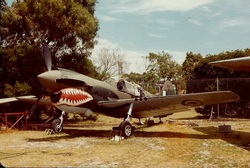Curtiss P-40E Kittyhawk

The Curtis P-40 series of single seat fighter aircraft was a refinement of the Curtis P-36 Hawk, and first flew in 1938 and the total of all variants built when production ceased in November 1944
was 13,738.
The name changed with variants, with British Commonwealth Air Forces calling the original P-40, P-40B and P-40C, Tomahawk, and the P-40D and later variants, Kittyhawk.
It was an excellent ground attack aircraft, could hold its own at low and medium altitudes but proved inferior to enemy interceptors at high altitudes. However with tactics evolved highlighting the aircraft's rapid acceleration in a dive to high speed, with high "G" manoeuvrability, it was ideally suited to the dive, shoot, and dive away, form of attack. It could also absorb large amounts of battle damage and still get back to base.
The RAAF operated 848 P-40s of several variants during WW2. Nos 3 and 450 Squadrons served with the desert Air Force in Nth Africa, while Nos 75,76,77,78.80, 82 and 86 served in the defence of Australia in the South West Pacific theatre , mainly in New Guinea and Borneo. Nos 75 and 76 Squadrons played a major role in the first defeat of a Japanese land force at Milne Bay in August 1942. Earlier, No 75 squadron had featured in the successful repelling of the Japanese drive on Pt Moresby New Guinea.
The Museum's Curtis P-40, A29-53 was one of the 163 P-40E variants serving with Nos 76 and 77 Squadrons.
Post war it was in private hands before being donated to the Museum in 1965, and for many years at the Museum, it was fitted to a pair of P-51 Mustang wings as the above image shows, and nicknamed "Kittystang".
It is currently well advanced in a complete restoration program at Moorabbin.
TECHNICAL DATA
Power plant : 1 x 1,150hp Allison V-1710 V12 cylinder liquid cooled piston engine.
Length : 31'09'' (9.68m) Wingspan : 37'04'' (11.67m) Height : 12'04'' (3.7m)
Weights : empty - 6,200lbs (2,812kg) maximum - 8,850lbs (4,120kg)
Speeds : maximum - 300kt (362mph) 540km/hr) cruise - 196kt (235mph) (376km/hr)
Range : 850 miles (1,360km)
was 13,738.
The name changed with variants, with British Commonwealth Air Forces calling the original P-40, P-40B and P-40C, Tomahawk, and the P-40D and later variants, Kittyhawk.
It was an excellent ground attack aircraft, could hold its own at low and medium altitudes but proved inferior to enemy interceptors at high altitudes. However with tactics evolved highlighting the aircraft's rapid acceleration in a dive to high speed, with high "G" manoeuvrability, it was ideally suited to the dive, shoot, and dive away, form of attack. It could also absorb large amounts of battle damage and still get back to base.
The RAAF operated 848 P-40s of several variants during WW2. Nos 3 and 450 Squadrons served with the desert Air Force in Nth Africa, while Nos 75,76,77,78.80, 82 and 86 served in the defence of Australia in the South West Pacific theatre , mainly in New Guinea and Borneo. Nos 75 and 76 Squadrons played a major role in the first defeat of a Japanese land force at Milne Bay in August 1942. Earlier, No 75 squadron had featured in the successful repelling of the Japanese drive on Pt Moresby New Guinea.
The Museum's Curtis P-40, A29-53 was one of the 163 P-40E variants serving with Nos 76 and 77 Squadrons.
Post war it was in private hands before being donated to the Museum in 1965, and for many years at the Museum, it was fitted to a pair of P-51 Mustang wings as the above image shows, and nicknamed "Kittystang".
It is currently well advanced in a complete restoration program at Moorabbin.
TECHNICAL DATA
Power plant : 1 x 1,150hp Allison V-1710 V12 cylinder liquid cooled piston engine.
Length : 31'09'' (9.68m) Wingspan : 37'04'' (11.67m) Height : 12'04'' (3.7m)
Weights : empty - 6,200lbs (2,812kg) maximum - 8,850lbs (4,120kg)
Speeds : maximum - 300kt (362mph) 540km/hr) cruise - 196kt (235mph) (376km/hr)
Range : 850 miles (1,360km)
